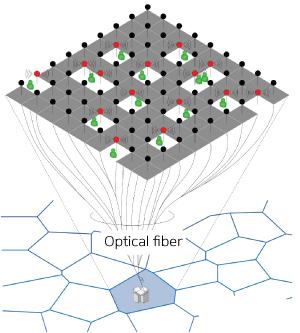Many antennas, multiple benefits

By combining large distributions of compact antenna nodes with fast fiber optic communication, researchers have developed a new wireless infrastructure ready for intense future demands. © 2014 A*STAR Institute for Infocomm Research
A concept that balances large-scale installations of low-cost and low-power antennas to boost cellular coverage in difficult environments will also provide better connectivity to more users. Developed by A*STAR, this new architecture for wireless communications can help service providers meet growing demands for increased network capacity and improved energy efficiency [1].
Jingon Joung, Yeow Chia and Sumei Sun from the A*STAR Institute for Infocomm Research in Singapore sought to combine two state-of-the-art wireless technologies into a novel type of antenna system. The first technology, known as large-scale multiple-input multiple-output (L-MIMO), uses numerous ‘co-located’ antennas to significantly reduce relative noise levels inside devices. The second, called distributed-antenna systems (DAS), replaces conventional high-power antennas with strategically placed compact nodes that can split up and transmit signals more efficiently due to improved line-of-sight pathways.
The team’s strategy, known as large-scale distributed-antenna systems (L-DAS), seeks to implement DAS with a massive installation base, as seen with MIMO antennas (see image). To realize this goal, however, required a way to evaluate the costs and benefits associated with this innovative infrastructure — simply increasing the number of antenna nodes does not automatically improve wireless network efficiency.
Using a complex computer simulator, the researchers quantified the performances of multi-user L-DAS networks by evaluating their energy efficiencies (that is, the number of bits decoded per joule). According to Joung, modeling energy efficiency is challenging because L-DAS antennas communicate in two ways — wirelessly or through fiber-optic cables — and each channel has different and often proprietary power requirements.
“Another challenge is implementing real-world parameters in the L-DAS network simulator,” says Joung. “Many of these parameters have a large dynamic range, from a few quadrillionths of a watt to tens of watts, which can cause precision issues with the computer simulation.”
At first glance, the original ‘naive’ L-DAS setup seemed to have a greater energy consumption than the L-MIMO system with co-located antennas. However, the team identified four key attributes that could dramatically enhance the L-DAS energy efficiency: proper antenna selection, clustering of antennas, pre-coding to improve channel quality, and computerized power control. With these improvements, the L-DAS network outperformed both L-MIMO and DAS technologies.
The group is now looking to the future. “Heterogeneous network (HetNet) architectures that can seamlessly support different 2G, 3G, 4G or WLAN networks are strong candidates for future communication networks,” says Joung. “Because L-DAS architecture can be applied to many HetNet applications, this work can help ensure a gentle and smooth replacement of real-life networks with HetNet.”
The A*STAR-affiliated researchers contributing to this research are from the Institute for Infocomm Research
Reference:
[1] Joung, J., Chia, Y. K. & Sun, S. Energy-efficient, large-scale distributed-antenna system (L-DAS) for multiple users. IEEE Journal of Selected Topics in Signal Processing 8, 954–965 (2014).
Associated links
A*STAR article
Media Contact
All latest news from the category: Power and Electrical Engineering
This topic covers issues related to energy generation, conversion, transportation and consumption and how the industry is addressing the challenge of energy efficiency in general.
innovations-report provides in-depth and informative reports and articles on subjects ranging from wind energy, fuel cell technology, solar energy, geothermal energy, petroleum, gas, nuclear engineering, alternative energy and energy efficiency to fusion, hydrogen and superconductor technologies.
Newest articles

NASA: Mystery of life’s handedness deepens
The mystery of why life uses molecules with specific orientations has deepened with a NASA-funded discovery that RNA — a key molecule thought to have potentially held the instructions for…

What are the effects of historic lithium mining on water quality?
Study reveals low levels of common contaminants but high levels of other elements in waters associated with an abandoned lithium mine. Lithium ore and mining waste from a historic lithium…

Quantum-inspired design boosts efficiency of heat-to-electricity conversion
Rice engineers take unconventional route to improving thermophotovoltaic systems. Researchers at Rice University have found a new way to improve a key element of thermophotovoltaic (TPV) systems, which convert heat…



